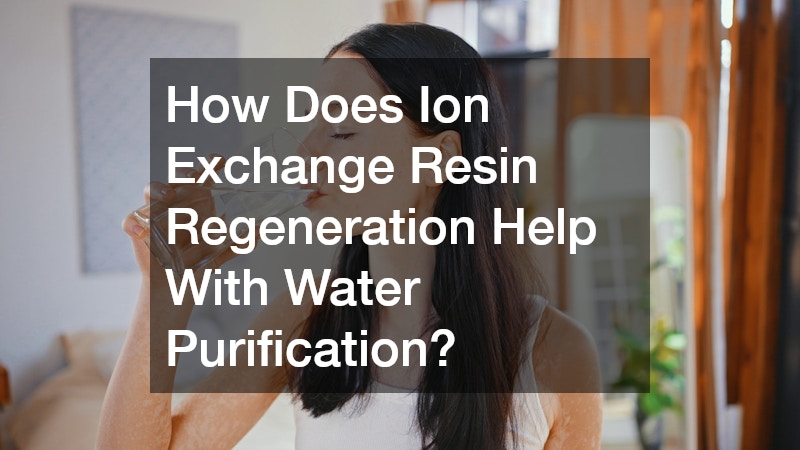
Ion exchange resins are a key component in the water purification process, contributing significantly to the removal of impurities. These resins are small, porous beads made of organic polymer substrates capable of exchanging ions with those in the surrounding solution. Specifically used for removing hardness ions such as calcium and magnesium, they maintain the water’s potability and utility. By utilizing a matrix structure of functional groups, ion exchange resins can attract and replace unwanted ions with preferable ones like sodium or hydrogen. This exchange is crucial in various applications ranging from residential water softeners to large-scale industrial water treatment systems.
The unique structure of ion exchange resins is designed to cope with different ionic compositions. For example, cation exchange resins specifically target positively charged ions, while anion resins are used for negatively charged ions, enhancing the flexibility of purification systems. These resins can be customized to meet specific purification needs, depending on the contaminants present in the water source. Through this customization, ion exchange resins ensure that the highest quality water is produced for diverse applications. Their versatility and efficiency greatly underscore their importance in daily water purification tasks.
One of the most significant advantages of ion exchange resins is their ability to regenerate after being used for removing ions. Without the regeneration process, these resins would quickly become saturated and lose their effectiveness. Ion exchange resin regeneration enables the beads to release the impurity ions they have collected, effectively resetting them for continued use. Regeneration can involve strong acids or bases to replenish the service capacity of the resin beads. Consequently, ion exchange resins can be used repeatedly, representing a sustainable and cost-effective approach to water purification.
The Role of Ion Exchange Resin Regeneration

Regeneration is a critical aspect of maintaining the functionality and longevity of ion exchange resins in water purification systems. During regeneration, the exhausted resin beads release collected ions back into a waste stream, which is then flushed out, allowing the resin to restore its ion-exchanging capabilities. This process involves flushing the resins with a concentrated solution—either acidic or alkaline, depending on the type of resin—thus rejuvenating them for reuse. Skipping regeneration would not only compromise water quality but also lead to higher operational costs due to more frequent resin replacements. Therefore, ion exchange resin regeneration is indispensable for the economic and practical operation of water purification systems.
Key factors influencing the effectiveness of the regeneration process include the concentration of the regenerant solution, contact time, and the flow rate of the solution through the resin. Each parameter needs to be optimized to ensure thorough removal of the depleted ions and proper restoration of resin capacity. Generally, a balance is sought to maximize regeneration efficiency while minimizing the use of chemicals. The development of advanced regeneration protocols, including the use of automated systems, has further improved the consistency and efficiency of this process. By maintaining peak performance through effective regeneration, ion exchange systems can deliver consistently high-quality water.
Another essential benefit of ion exchange resin regeneration is its contribution to environmental sustainability. Since the resins are essentially recycled during the regeneration process, the demand for new resin production is lowered, resulting in less waste and resource consumption. Furthermore, the regeneration process can be optimized to minimize its environmental impact by recovering and reusing regeneration chemicals when feasible. Thus, ion exchange resin regeneration not only sustains the functional capacity of resins but also reduces the ecological footprint of water treatment operations. This dual benefit emphasizes the importance of developing efficient regeneration methodologies and practices across various water purification contexts.
Applications and Benefits of Ion Exchange Resin Regeneration in Modern Water Treatment
In modern water treatment plants, ion exchange resins are integral to processes like water softening and deionization. The versatile nature of ion exchange resin regeneration allows plants to efficiently manage both time and resources, contributing to a steady supply of purified water. By maintaining the ionic exchange capacity of resins through regular regeneration, water quality compliance is consistently achieved. This continuous cycle of use and regeneration ensures that the water treatment plants operate at optimal levels with reduced downtime. Moreover, the reuse of resins reduces waste and environmental impact, aligning with sustainability goals that modern plants prioritize.
A specific application of ion exchange resin regeneration can be seen in industrial setups where high-purity water is required for processes such as pharmaceuticals, food & beverage production, and chemical manufacturing. In these industries, precise water quality is non-negotiable, and any compromise could lead to product defects or safety concerns. Ion exchange resins, when effectively regenerated, guarantee that any ion-induced impurities are systematically removed, thus maintaining the high-purity standards required. As a result, businesses can both uphold safety regulations and reduce operational costs due to the efficient recycling of resins. The scalability and adaptability of ion exchange systems make them well-suited for various industrial requirements.
On a larger scale, municipal water treatment facilities benefit significantly from the simple yet effective mechanism of ion exchange resin regeneration. These facilities typically handle large volumes of water, necessitating reliable and consistent purification protocols to meet the demands of a growing population. With advancements in regeneration technology, these facilities can enhance the longevity and efficiency of their water treatment infrastructures. The sustainability advantages offered by resin regeneration further help municipalities meet environmental guidelines and reduce their overall carbon footprint. Ultimately, the effective use of ion exchange resin regeneration is central to delivering safe, clean water to communities worldwide.
